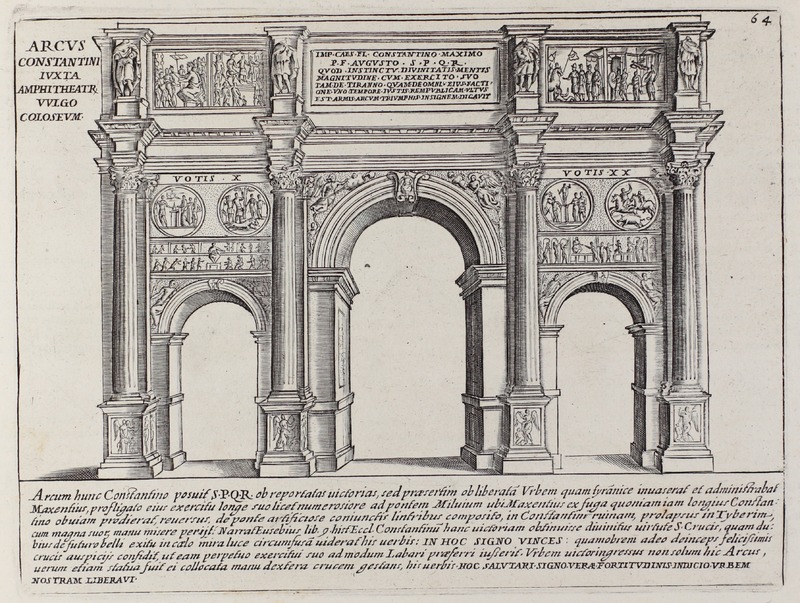17th Century
In this engraving, artist Giacomo Lauro (1584-1637) illustrates the south side of the Arch of Constantine. Built to commemorate the emperor Constantine’s victory over Maxentius in 312 AD, the arch combines reliefs constructed during Constantine’s rule with reused sculptures produced during the reigns of earlier emperors.[1] Beginning at the top of the arch, Lauro portrays sculptures representing Dacian prisoners above the monument’s four Corinthian columns. These sculptures originated from the time of Emperor Trajan, when Rome celebrated its military victories over Dacian tribes. The artist also depicts the inscription above the central archway that states the arch was given to Constantine by the senate and people of Rome. Lauro’s engraving illustrates a series of four relief panels on the monument’s attic, likely adopted from a lost arch for the emperor of Marcus Aurelius.[2] Beneath the attic and above both lateral archways, Lauro delineates two round reliefs that likely originated in the Hadrianic period, and a sculptural frieze celebrating Constantine’s war victories.[2] Personifications of victory are represented in the spandrels above the central archway, while depictions of river gods are included in the spandrels over the lateral archways. Finally, at the base of each column, Lauro portrays Constantinian relief panels illustrating winged victories with captives.
This engraving appears to represent the south side of the Arch of Constantine in its original state. Though many of the monument’s features would have exhibited signs of wear and tear by the sixteenth and seventeenth centuries, Lauro chooses not to render the arch in a dilapidated state. Instead, he depicts the arch in its original format, enabling the viewer to observe the juxtaposition of different Roman artistic styles without becoming distracted by the monument’s signs of age.
__________________________________________________________________________
1. Marina Prusac, “The Arch of Constantine: Continuity and Commemoration through Reuse,” Acta Ad Archaeologiam Et Artivm Historiam Pertinentian (25): 127.
2. Jessica Hughes, “Memory and the Roman Viewer: Looking at the Arch of Constantine,” in Memoria Romana: Memory in Rome and Rome in Memory, ed. by Karl Galinsky (Ann Arbor: University of Michigan Press, 2014): 104-106.
